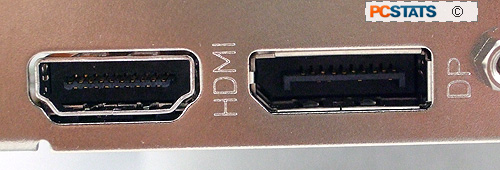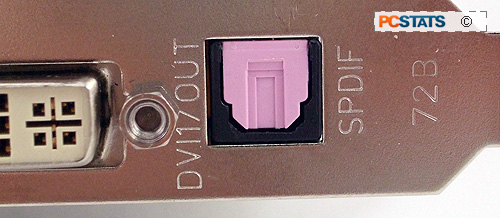There are quite a few Geforce 9600GT videocards being
released to satisfy consumer demand, but standing out from the crowd isn't
always easy with a mainstream videocard. Palit have taken a unique approach with
the 9600GT Sonic by including a physical HDMI jack that supports an audio stream
right at the back of the videocard. No dongle required. Next to the HDMI jack is
something new, a video out connector called the DisplayPort.
What is a DisplayPort and where does it come
from?
DisplayPort is the baby of VESA, the display
standards association. VESA has the rather mundane task of making sure monitors
and displays all work regardless of who makes them, what screen technology is
used or how they are connected to a computer. In the basic sense, VESA set
the standards that make interoperability work.
VESA's latest baby is the DisplayPort - a flexible open
standard which seeks to address the requirements of all external and embedded
display applications. Put another way, with DisplayPort VESA want to make the
15-pin Analog VGA and Digital DVI monitor cable standards, S-Video and Component
formats obsolete. It proposes to replace those five different video standards
with one cable, the DP cable.

The DisplayPort looks like an HDMI connector, but the two are different. It's digital, so VESA envision
DP-to-HDMI and DP-to-DVI adaptor cables. It's unlikely consumers will willingly toss out
old monitors just for a new display connection standard to hook up
everything after all, so expect adaptors in the future if DP really
takes hold.
Since the DisplayPort is a digital signal
based video transmission standard (with room for a few extras), it's
HDCP 1.3 and DPCP 1.0 compliant. A few other features make DisplayPort an
interesting future proof technology that's likely to be broadly adopted; direct
drive LCD support, higher bandwidth than a DVI cable, better HDMI/DVI support
via adaptors, ability to transfer audio, content protection, reduced
complexity and space savings at the back of the computer.

DisplayPort enables a system (not unlike the PCI
Express format) which can scale with bandwidth demands. DisplayPort has four lanes with a
bandwidth of 1.6Gbit/s or 2.7Gbit/s per lane for a maximum bandwidth of
10.8GBit/s. This could support a WQXGA-10bit monitor at a resolution of 2560x1600 with
ease.

Audio Inputs: Digital 2-pin and Optical
SP/DIF
The Palit 9600GT Sonic stands out for one other reason -
an optical SP/DIF jack at the rear. There is a digital 2-pin audio header at the
top of the 9600GT, right next to the nVidia SLI connector too. Either of these audio inputs is used to bring an
audio signal into the Palit 9600GT so it can output audio over the HDMI or DP
cable. Virtually every motherboard has an audio header, so this is the most convenient route
to take, for the motherboard to deliver audio to the Geforce 9600GT.

The optical audio input port provides some added
flexibility, in that the Palit 9600GT Sonic could be rapidly connected to a
stand alone audio card. A short optical SP/DIF cable is included with the videocard, as is the
two-pin internal audio jumper. The reason for all of this is nVidia's graphics
cards do not incorporate an audio codec, the audio signal needs to be
connected to the videocard. The HDMI cable can then carry both video and audio
to awaiting HDTVs.
